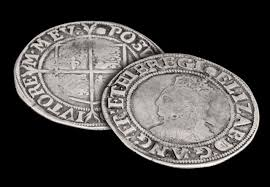People will use the other coins
If you want people to use devaluing currency, then ALL of your coins need to devalue, and the amount they devalue has to be proportionally equal, measurable, uncontestable, and unmistakable for all coin types. If they are not, then people will just find something more reliable to use as currency.
If the 3p coin is the only one that devalues, then they will not see any use. No person in thier right mind will accept payment in 3p coins, they will simply refuse the payment and instead insist on being paid in 3 1p coins instead. Knowing this, no store owner or employer will ever accept a withdrawal in 3p coins either. Your 1p coins need to in the same amount of time become worth 2/3p, your shillings devalue to 8p, etc.
The second issue with your devaluing currency is that it is not measurable. Part of what makes money worth using that it represents a specific worth. If the coins slowly change color over time, then no two people will agree on when a coin has changed color enough to change its value. If red polished copper coin is 3p and tarnished black copper coin is 2p, then what is a brown copper coin worth?
It would take literal magic to make coins spontaneously change color from a 3p to a 2p coin in order to make it measurable. But that leads into the next issue of needing coins to be uncontestable. If I give you 3p that magically turns into 2p the second it touches your hand, then have I short changed you? Did you see that it started off as a 3p coin? If this happens, do I owe you an extra 1p coin or are you expected to eat the cost? No matter what, one of us is going to be arguing about how much money I just gave you, and if this is a common occurrence, then con-men will make a habit of giving people 2p coins and then arguing it was a 3p coin.
The contestability issue could be mitigated if you know at what point the coin will devalue, like if instead of being triggered by handling, you print on it: "This coin is worth 3p until the year 1498DR", but still not good because then a coin that devalues in 1498 is no longer proportional to one that is good until 1501. So, just like with not making all coins devalue proportionally, people will still want to argue about what coins they will accept as payments. Also, if you have printed devalue dates, the coins no longer become unmistakeable. If I have a stack of new coins, it would be easy to try to hide some old ones in it and hope that the vendor mistakes it for a whole stack of new 3p coins.
A better way to make devaluing coins is to use zinc
The best way to make coins devalue is to make all of them out of a substance that quickly loses mass over time. Historically, most coins were made out of very chemically stable metals like silver and gold but zinc is a very unstable metal that easily rubs away and corrodes. If 1 gram of zinc coin is always worth 1p, then a 3g coin will soon enough corrode down to 2g making it worth 2p. Since all coins are made of zinc, they will all devalue more or less equally; so, no one will argue about being paid in one denomination over another. Your coins will always have a weight that can be precisely measured; so, if I measure my 11 coins as worth 9p someone else can measure thier weight and come to the same evaluation. They also never change value when you hand them to someone; so, there is nothing about the transaction itself to contest. And they are unmistakable, because it is their weight and not what exactly they look like that sets thier worth.
If you want your coins to devalue by 1/3rd and then stop devaluing, it's even better because you can then use zinc to create a bimetallic coin which uses an outer rim made of copper, silver, or gold impregnated with a core that is 1/3 of the coin's total weight. The zinc slowly eats away making the coin lighter, but the government basically says that as long as the zinc fits flush into the X diameter hole in the Y diameter coin, you can weigh it the same as a pure coin of that metal.
The Economic Impact
Using devaluing currency is not much different than inflation. It will encourage people to convert thier money into things that are not money: real-estate, commodities, investments, etc. However, it does come with the advantage that it reduces actual inflation by quite a bit. This would help stabilize prices and salaries over longer periods of time which would eliminate some of the economic problems that happen when prices get fixed. So, a shilling a week today could be just as reasonable as it was 50 years ago, even if the government continues to mint new coins each year.
Another interesting side effect could be government sectioned refurbishment. Obviously, recoreing a coin is illegal, but as with many things, its only illegal when you are not the government. When you pay your taxes with an old coin, it might only be worth 2.4p. Then the government could without having to invest in any new precious metals, recore the coin with zinc restoring it to its 3p value for a very tiny fraction of the cost of a new coin. In this way, the government could reduce how much taxes they need to collect and thier operational overhead of minting new currency.





